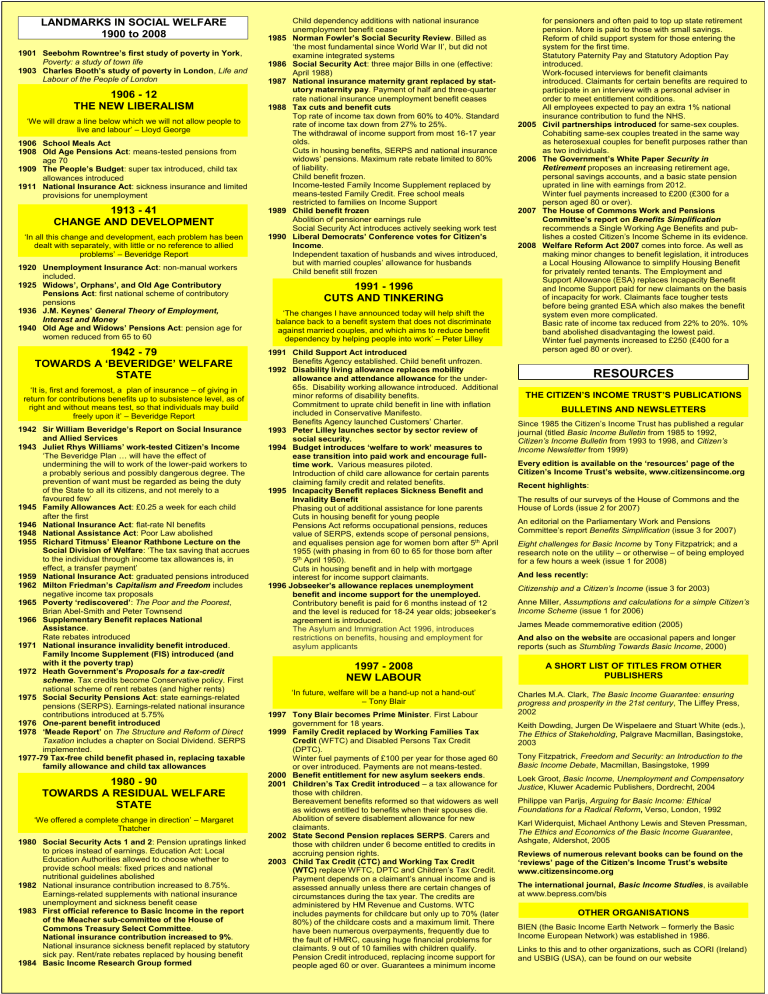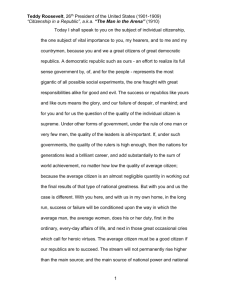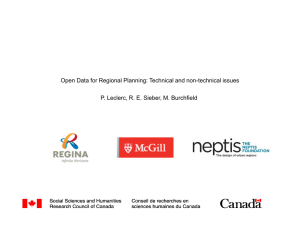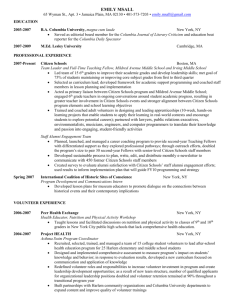Student leaflet, 2008 (A3 size)

LANDMARKS IN SOCIAL WELFARE
1900 to 2008
1901
Seebohm Rowntree’s first study of poverty in York
,
Poverty: a study of town life
1903 Charles Booth’s study of poverty in London , Life and
Labour of the People of London
1906 - 12
THE NEW LIBERALISM
‘We will draw a line below which we will not allow people to live and labour’ – Lloyd George
1906 School Meals Act
1908 Old Age Pensions Act : means-tested pensions from age 70
1909 The People’s Budget : super tax introduced, child tax allowances introduced
1911 National Insurance Act : sickness insurance and limited provisions for unemployment
1913 - 41
CHANGE AND DEVELOPMENT
‘In all this change and development, each problem has been dealt with separately, with little or no reference to allied problems’ – Beveridge Report
1920 Unemployment Insurance Act : non-manual workers included.
1925 Widows’, Orphans’, and Old Age Contributory
Pensions Act : first national scheme of contributory pensions
1936
J.M. Keynes’ General Theory of Employment,
Interest and Money
1940 Old
Age and Widows’ Pensions Act
: pension age for women reduced from 65 to 60
1942 - 79
TOWARDS A ‘BEVERIDGE’ WELFARE
STATE
‘It is, first and foremost, a plan of insurance – of giving in return for contributions benefits up to subsistence level, as of right and without means test, so that individuals may build freely upon it’ – Beveridge Report
1942 Sir William Beveridge’s Report on Social Insurance and Allied Services
1943 Juliet Rhys Williams’ work-tested Citizen’s Income
‘The Beveridge Plan … will have the effect of undermining the will to work of the lower-paid workers to a probably serious and possibly dangerous degree. The prevention of want must be regarded as being the duty of the State to all its citizens, and not merely to a favoured few’
1945 Family Allowances Act
: £0.25 a week for each child after the first
1946 National Insurance Act : flat-rate NI benefits
1948 National Assistance Act : Poor Law abolished
1955
Richard Titmuss’ Eleanor Rathbone Lecture on the
Social Division of Welfare
: ‘The tax saving that accrues to the individual through income tax allowances is, in effect, a transfer payment’
1959 National Insurance Act : graduated pensions introduced
1962
Milton Friedman’s Capitalism and Freedom
includes negative income tax proposals
1965 Poverty
‘rediscovered’
: The Poor and the Poorest ,
Brian Abel-Smith and Peter Townsend
1966 Supplementary Benefit replaces National
Assistance .
Rate rebates introduced
1971 National insurance invalidity benefit introduced .
Family Income Supplement (FIS) introduced (and with it the poverty trap)
1972
Heath Government’s Proposals for a tax-credit scheme . Tax credits become Conservative policy. First national scheme of rent rebates (and higher rents)
1975 Social Security Pensions Act : state earnings-related pensions (SERPS). Earnings-related national insurance contributions introduced at 5.75%
1976 One-parent benefit introduced
1978
‘Meade Report’ on The Structure and Reform of Direct
Taxation includes a chapter on Social Dividend. SERPS implemented.
1977-79 Tax-free child benefit phased in, replacing taxable family allowance and child tax allowances
1980 - 90
TOWARDS A RESIDUAL WELFARE
STATE
‘We offered a complete change in direction’ – Margaret
Thatcher
1980 Social Security Acts 1 and 2 : Pension upratings linked to prices instead of earnings. Education Act: Local
Education Authorities allowed to choose whether to provide school meals: fixed prices and national nutritional guidelines abolished
1982 National insurance contribution increased to 8.75%.
Earnings-related supplements with national insurance unemployment and sickness benefit cease
1983 First official reference to Basic Income in the report of the Meacher sub-committee of the House of
Commons Treasury Select Committee .
National insurance contribution increased to 9% .
National insurance sickness benefit replaced by statutory sick pay. Rent/rate rebates replaced by housing benefit
1984 Basic Income Research Group formed
Child dependency additions with national insurance unemployment benefit cease
1985 Norman Fo wler’s Social Security Review . Billed as
‘the most fundamental since World War II’, but did not examine integrated systems
1986 Social Security Act : three major Bills in one (effective:
April 1988)
1987 National insurance maternity grant replaced by statutory maternity pay . Payment of half and three-quarter rate national insurance unemployment benefit ceases
1988 Tax cuts and benefit cuts
Top rate of income tax down from 60% to 40%. Standard rate of income tax down from 27% to 25%.
The withdrawal of income support from most 16-17 year olds.
Cuts in housing benefits, SERPS and national insurance widows’ pensions. Maximum rate rebate limited to 80% of liability.
Child benefit frozen.
Income-tested Family Income Supplement replaced by means-tested Family Credit. Free school meals restricted to families on Income Support
1989 Child benefit frozen
Abolition of pensioner earnings rule
Social Security Act introduces actively seeking work test
1990 Liberal Democrats’ Conference votes for Citizen’s
Income .
Independent taxation of husbands and wives introduced, but with married couples’ allowance for husbands
Child benefit still frozen
1991 - 1996
CUTS AND TINKERING
‘The changes I have announced today will help shift the balance back to a benefit system that does not discriminate against married couples, and which aims to reduce benefit dependency by helping p eople into work’ – Peter Lilley
1991 Child Support Act introduced
Benefits Agency established. Child benefit unfrozen.
1992 Disability living allowance replaces mobility allowance and attendance allowance for the under-
65s.
Disability working allowance introduced. Additional minor reforms of disability benefits.
Commitment to uprate child benefit in line with inflation included in Conservative Manifesto.
Benefits Agency launched Customers’ Charter.
1993 Peter Lilley launches sector by sector review of social security.
1994 Budget introduces ‘welfare to work’ measures to ease transition into paid work and encourage fulltime work. Various measures piloted.
Introduction of child care allowance for certain parents claiming family credit and related benefits.
1995 Incapacity Benefit replaces Sickness Benefit and
Invalidity Benefit
Phasing out of additional assistance for lone parents
Cuts in housing benefit for young people
Pensions Act reforms occupational pensions, reduces value of SERPS, extends scope of personal pensions, and equalises pension age for women born after 5 th April
1955 (with phasing in from 60 to 65 for those born after
5 th April 1950).
Cuts in housing benefit and in help with mortgage interest for income support claimants.
1996 Jobseeker’s allowance replaces unemployment benefit and income support for the unemployed.
Contributory benefit is paid for 6 months instead of 12 and the level is reduced for 18-
24 year olds; jobseeker’s agreement is introduced.
The Asylum and Immigration Act 1996, introduces restrictions on benefits, housing and employment for asylum applicants
1997 - 2008
NEW LABOUR
‘In future, welfare will be a hand-up not a hand-out’
– Tony Blair
1997 Tony Blair becomes Prime Minister . First Labour government for 18 years.
1999 Family Credit replaced by Working Families Tax
Credit (WFTC) and Disabled Persons Tax Credit
(DPTC).
Winter fuel payments of £100 per year for those aged 60 or over introduced. Payments are not means-tested.
2000 Benefit entitlement for new asylum seekers ends .
2001
Children’s Tax Credit introduced – a tax allowance for those with children.
Bereavement benefits reformed so that widowers as well as widows entitled to benefits when their spouses die.
Abolition of severe disablement allowance for new claimants.
2002 State Second Pension replaces SERPS . Carers and those with children under 6 become entitled to credits in accruing pension rights.
2003 Child Tax Credit (CTC) and Working Tax Credit
(WTC) replace WFTC, DPTC and Children’s Tax Credit.
Payment depends on a claimant’s annual income and is assessed annually unless there are certain changes of circumstances during the tax year. The credits are administered by HM Revenue and Customs. WTC includes payments for childcare but only up to 70% (later
80%) of the childcare costs and a maximum limit. There have been numerous overpayments, frequently due to the fault of HMRC, causing huge financial problems for claimants. 9 out of 10 families with children qualify.
Pension Credit introduced, replacing income support for people aged 60 or over. Guarantees a minimum income for pensioners and often paid to top up state retirement pension. More is paid to those with small savings.
Reform of child support system for those entering the system for the first time.
Statutory Paternity Pay and Statutory Adoption Pay introduced.
Work-focused interviews for benefit claimants introduced. Claimants for certain benefits are required to participate in an interview with a personal adviser in order to meet entitlement conditions.
All employees expected to pay an extra 1% national insurance contribution to fund the NHS.
2005 Civil partnerships introduced for same-sex couples.
Cohabiting same-sex couples treated in the same way as heterosexual couples for benefit purposes rather than as two individuals.
2006
The Government’s White Paper Security in
Retirement proposes an increasing retirement age, personal savings accounts, and a basic state pension uprated in line with earnings from 2012.
Winte r fuel payments increased to £200 (£300 for a person aged 80 or over).
2007 The House of Commons Work and Pensions
Committee’s report on Benefits Simplification recommends a Single Working Age Benefits and publishes a costed Citizen’s Income Scheme in its evidence.
2008 Welfare Reform Act 2007 comes into force. As well as making minor changes to benefit legislation, it introduces a Local Housing Allowance to simplify Housing Benefit for privately rented tenants. The Employment and
Support Allowance (ESA) replaces Incapacity Benefit and Income Support paid for new claimants on the basis of incapacity for work. Claimants face tougher tests before being granted ESA which also makes the benefit system even more complicated.
Basic rate of income tax reduced from 22% to 20%. 10% band abolished disadvantaging the lowest paid.
Winter fuel payments increased to £250 (£400 for a person aged 80 or over).
RESOURCES
THE CITIZEN’S INCOME TRUST’S PUBLICATIONS
BULLETINS AND NEWSLETTERS
Since 1985 the Citizen’s Income Trust has published a regular journal (titled Basic Income Bulletin from 1985 to 1992,
Citizen’s Income Bulletin
from 1993 to 1998, and
Citizen’s
Income Newsletter from 1999)
Every edition is available on the ‘resources’ page of the
Citizen’s Income Trust’s website, www.citizensincome.org
Recent highlights :
The results of our surveys of the House of Commons and the
House of Lords (issue 2 for 2007)
An editorial on the Parliamentary Work and Pensions
Committee’s report
Benefits Simplification (issue 3 for 2007)
Eight challenges for Basic Income by Tony Fitzpatrick; and a research note on the utility – or otherwise – of being employed for a few hours a week (issue 1 for 2008)
And less recently:
Citizenship and a Citizen’s Income
(issue 3 for 2003)
Anne Miller, Assumptions and calculations for a simple Citizen’s
Income Scheme (issue 1 for 2006)
James Meade commemorative edition (2005)
And also on the website are occasional papers and longer reports (such as Stumbling Towards Basic Income , 2000)
A SHORT LIST OF TITLES FROM OTHER
PUBLISHERS
Charles M.A. Clark, The Basic Income Guarantee: ensuring progress and prosperity in the 21st century , The Liffey Press,
2002
Keith Dowding, Jurgen De Wispelaere and Stuart White (eds.),
The Ethics of Stakeholding , Palgrave Macmillan, Basingstoke,
2003
Tony Fitzpatrick, Freedom and Security: an Introduction to the
Basic Income Debate , Macmillan, Basingstoke, 1999
Loek Groot, Basic Income, Unemployment and Compensatory
Justice , Kluwer Academic Publishers, Dordrecht, 2004
Philippe van Parijs, Arguing for Basic Income: Ethical
Foundations for a Radical Reform, Verso, London, 1992
Karl Widerquist, Michael Anthony Lewis and Steven Pressman,
The Ethics and Economics of the Basic Income Guarantee ,
Ashgate, Aldershot, 2005
Reviews of numerous relevant books can be found on the
‘reviews’ page of the Citizen’s Income Trust’s website www.citizensincome.org
The international journal, Basic Income Studies , is available at www.bepress.com/bis
OTHER ORGANISATIONS
BIEN (the Basic Income Earth Network – formerly the Basic
Income European Network) was established in 1986.
Links to this and to other organizations, such as CORI (Ireland) and USBIG (USA), can be found on our website
CITIZEN’S INCOME
AN INTRODUCTION
1 What is a Citizen’s Income?
A Citizen’s Income (CI) is an unconditional, automatic and nonwithdrawable payment to each individual as a right of citizenship.
(A Citizen’s Income is sometimes called a Basic Income (BI), a
Universal Grant, or a Universal Benefit)
A Citizen’s Income scheme would phase out as many reliefs and allowances against personal income tax and as many existing state financed cash benefits as possible, and replace them with a Citizen’s Income paid automatically to every man, woman and child.
The Citizen’s Income attack on poverty is three pronged. Such a scheme would
end the poverty and unemployment traps, hence boosting employment
provide a safety net from which no citizen would be excluded
create a platform on which all citizens are free to build
A Citizen’s Income scheme would encourage individual freedom and responsibility and help to
bring about social cohesion. Everybody is entitled to a
Citizen’s Income and everybody pays tax on all other income*
end perverse incentives that discourage work and savings.
A Citizen’s Income would be simple and efficient and would be:
affordable within current revenue and expenditure constraints
easy to understand. It would be a universal entitlement based on citizenship that is non-contributory, non-means tested and non-taxable
cheap to administer and to automate
* A Citizen’s Income varies only with age; and there will be additions for disability
2 How would it work?
A Citizen’s Income scheme would co-ordinate the income tax and benefits systems. A single government agency would credit the Citizen’s Incomes automatically and recoup the cost via income tax levied on all income rather than running separate systems of means testing, benefit withdrawal, and taxation.
Instead of different rules for claimants and taxpayers, everybody would be treated alike.
Automatic payments . Each week or each month, every legal resident would automatically be credited with the Citizen’s
Income appropriate to his or her age. For most adults this could be done through the banking system, and for children it could be done through the bank accounts of their parents. For adults without bank accounts special provisions would be necessary.
Citizen’s Income supplements would be paid to older people and those with chronic disabilities, but there would be no differences on account of gender or marital status, nor on account of work status, contribution record, or living arrangements.
Tax-free and without means test . The Citizen’s Incomes would be tax-free and without a means test, but tax would be payable on all, or almost all, other income. This is necessary in order to finance the scheme. The rate of tax would depend on the
Citizen’s Income amounts. The higher the Citizen’s Income, the higher the tax rate.
A new, comprehensive income tax.
There are various ways of funding a Citizen’s Income. The particular scheme discussed in this booklet is funded by removing tax allowances and reliefs and reducing means tested and contributory benefits. In addition, income tax and employees’ national insurance contributions would be merged into a new income tax.This booklet establishes the viability of a Citizen’s Income funded by income tax, but it could also be part of a wider tax reform package including, for example, a land value tax and/or a carbon tax.
3 Six fundamental changes
1. Citizenship becomes the basis of entitlement , subject to a minimum period of legal residency in the UK. Every citizen would have a small independent income, whether or not they are in paid employment.
2. The individual would be the tax/benefits unit . The Citizen’s
Income would be paid to individuals, not couples, families or households. Unlike the existing benefits system, Citizen’s
Income would be symmetrical between men and women.
Marriage, civil partnership and cohabitation would be neither subsidised nor penalised.
3.
The Citizen’s Income would not be withdrawn as earnings and other income rises , nor would it be reduced by owning assets. It would be a base on which to build without having to report to officials every minor change in earnings or household composition. Benefits fraud would be reduced significantly.
Work and savings of all types would be encouraged.
4. The availability-for-work rule would be abolished . Under the current system, young people in education or training and unemployed people who study or train for more than a few hours a week forfeit most benefits. With a Citizen’s Income this would not happen. School attendance, further and higher education, voluntary work, vocational training and re-training would all be facilitated.
5. Access to a Citizen’s Income would be easy and unconditional . Instead of the current maze of regulations, often resulting in perverse incentives, everybody would know their entitlement and their obligations. Take-up, as with child benefit
(currently the only form of Citizen’s Income in the UK), would be nearly 100%.
6. Benefit levels would be indexed to earnings or to GDP per capita rather than to prices . To index the Citi zen’s Income lower than this would merely store up problems for the future. Whilst all citizens would benefit from a more generous payment, there would be an equal and opposite pressure against income tax rises to fund it. So two basic variables – the Citizen’s Income level and the income tax rate required to fund it
– would be inherently linked and stable.
4 Integrating tax and social security
The current system
Putting housing-related benefits to one side, in 2006 the net income of a single earner aged 25 or over after income tax, national insurance contributions, income support/jobseeker’s allowance and working tax credits was as follows:
£200
£150
£100
£50
£0
Net wages
Benefits
2 8 14 20 26 32
Hours worked pw at national minimum wage
38
The chart clearly reveals the benefit trap. As earned income rises, earnings are taxed and benefits are withdrawn. Someone working between 11 and 16 hours per week retains their additional earnings in full, but when they work more than 16 hours per week and become entitled to tax credits, their net income rises much more slowly. If someone earning the natio nal minimum wage (£5.35 in 2006) starts working 40 rather than 16 hours, his or her gross income increases by £128 per week, but his or her net income increases by only £65 per week
– having suffered £34 in income tax and national insurance contributions a nd lost £29 in working tax credits. The increase in net income is only 51% of gross income, so there is a
‘marginal deduction rate’ or ‘withdrawal rate’ of 49%. For many family types, withdrawal rates are 85% of earned income up to nearly £400 per week; and for some family types and some earnings ranges the withdrawal rate is higher than 95%.
A Citizen’s Income proposal :
The relatively uncontroversial Citizen’s Income scheme proposed here assumes the following rates of Citizen’s Income:
Age
0 to 17
18 to 24
25 to 64
65 and over
Weekly CI 2006-07 rates:
£34
Income Support for 16-17 year olds
£45 Income Support for 18-24 year olds
£57
Income Support for 25-59 year olds
£114 Pensions Credit rate
£250
£200 Net wages
£150
£100
£50
£0
Citizen's income
2 8 14 20 26 32 38
Hours worked pw at national minimum wage
Overlapping the two previous charts shows that the system will increase work incentives at most levels of income:
£250
£200
£150
£100
£50
£0
2 8 14 20 26 32 38
Hours worked pw at national minimum wage
Current system
Citizen's income scheme
5
Paying for a Citizen’s Income scheme
The Citizen’s Income scheme outlined here is intended to be revenue and cost neutral. For simplicity, we shall assume a flat rate of tax on earned income of 33% (22% income tax plus 11% employee’s national insurance contributions), with a higher rate as at present on higher earnings. Rates of 22% are assumed for pensioners and of 20% for unearned income. The estimated total cost of benefits and tax reliefs and allowances that would be replaced is as follows:
Social security spending
Tax reliefs and allowances
DWP running costs
HMRC (tax credit administration)
Total
£100 bn
£94 bn
£6 bn
£1 bn
£201 bn
The total cost of the proposed scheme is as follows:
Age
0 to 17
18 to 24
25 to 64
65 and over
Running costs
(1%)
Total cost p.a.
Population survey 2006
13,912,600
4,770,800
32,141,500
9,708,100
60,533,000
Citizen’s Income per week
Cost
£34 £25 bn
£45 £11 bn
£57 £95 bn
£114 £58 bn
£189 bn
£2 bn
£191 bn
We assume that tax relief for pension contributions will be restricted to 22%, the same as the rate of income tax deducted from pensions in payment. Running costs are estimated at one per cent, which is the approximate cost of administering child benefit (non-contributory, non-means tested, non-taxable).
In the short term some of the £10bn saved will be needed to compensate those for whom transitional measures are required, as explained later.
That the UK can afford a Citizen’s Income scheme is also illustrated by the fact that per capita GDP was £391 per week in
2005 (UK National Accounts 2006, Table 1.5, Item IHXT).
For further details of these costings please request our introductory booklet, or download it from the front page of our website.
6 Transitional arrangements
There will be clear winners under the Citizen’s Income system proposed here, in particular:
earners with low or fluctuating incomes
students
families (with children) on low to average earnings
pensioners with small savings and pensioner couples
It is also clear that if the Citizen’s Income scheme were adopted outright then transitional measures will be required for
lone or widowed parents with no earned income who receive no maintenance from the absent or deceased parent
women aged between 60 and 65 eligible for the state pension
single earner households earning between £8,000 and
£16,000 per annum, for whom the Citizen’s Income envisaged would not compensate for the withdrawal of both child tax credit and working tax credit
civil servants at Her Majesty’s Revenue and Customs and the Department for Work and Pensions who have to be retrained or made redundant.
The Citizen’s Income scheme outlined here ignores the fact that some residents have not been in the UK long enough to qualify, and it also ignores pensioners living abroad who receive a state retirement pension. It is assumed that the two issues will cancel each other out so that a negligible overall cost or saving will be the result.
7 Housing-related benefits
The Citizen’s Income scheme outlined here has ignored housing and council tax benefits, which cost around £19bn annually, and the economic cost of below-market rents in the social rented sector esti mated at £7 bn in John Hills’ recent review. (John Hills, Ends and Means: the future roles of social housing in England , London School of Economics, 2007)
We are aware that housing-related benefits need radical simplification and reform but we believe that to be a separate debate and not directly related to the implementation of a
Citizen’s Income scheme. Such benefits are usually paid to households whereas it is fundamental to a Citizen’s Income that it is paid to individuals.
The Citizen’s Income Trust
The immediate reaction of most people when introduced to the idea of a Citizen’s Income is one of incredulity. It sounds too good to be true. The Basic Income Research Group was set up in 1984 to promote debate on the feasibility and desirability of a
Citi zen’s Income. ( BIRG was renamed the Citizen’s Income
Trust in 1992).
The Citizen’s Income Trust is not a pressure group, nor is it aligned to any political party. It publishes a regular Newsletter , maintains a website and a library, responds to requests for information, and undertakes research projects directly related to its aims. The Citizen’s Income Trust is a registered charity, no.
328198
How you can help
If you are interested in reform of the tax and benefits system, why not join our mailing list?
Email your contact details to info@citizensincome.org, or write to: Dr. Malcolm Torry, Director, Citizen’s Income Trust, P.O.
Box 26586, London SE3 7WY. Telephone: 020 8305 1222; fax:
020 8305 1802
© Copyright, Citizen’s Income Trust, 2008






